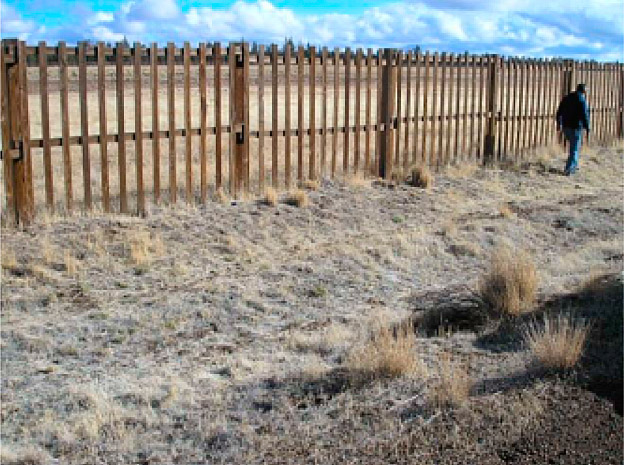11.9 Over the Horizon Backscatter (OTHB) Receiver Site, Tulelake, Modoc National Forest, Modoc County, CA
Organization: AECOM Technical Services
Email: [email protected]
11.9.1 Site Description and Conceptual Site Model
Site-specific oral relative bioavailability (RBA) of arsenic in soil was determined to inform risk-based decision making at a former U.S. Air Force installation in California. During the 1980s, treated wood fencing was installed around the site perimeter for several miles (Figure 11-10). Soluble arsenic from copper chromated arsenate (CCA) used in wood treatment has since leached and accumulated along the drip-line beneath the fence. Resulting concentrations in soil are as high as 940 mg/kg total arsenic, in comparison to individual background concentrations in the range of approximately 0.91 to 3.53 mg/kg. Arsenic is the primary risk for human health, and is associated with the incidental ingestion of soil. Removing the arsenic to background levels along the entire fence perimeter, however, is cost prohibitive.

Figure 11‑10. Site fencing.
The site is approximately 927 acres and consists of three sectors, Sectors 4, 5, and 6. The U.S. Forest Service (USFS) is the designated federal land management agency. Consequently, U.S. Department of Agriculture (USDA) and USFS regulations and policy govern current and future land use of the property. The area surrounding the sectors has been sparsely forested and, for the past 40 years, has been used for livestock grazing and harvesting of forest products.
The fencing surrounding the three sectors is 59,075 linear feet (approximately 11 miles). The fencing and fence posts are classified as treated wood waste (TWW) and are planned for removal. This waste stream must be handled in accordance with the California Code of Regulations Title 22, division 4.5, Chapter 34, Alternative Management Standards (AMS) for Treated Wood Waste. The AMS recognizes that TWW contains hazardous levels of chemicals such as arsenic, copper, and zinc.
11.9.2 Arsenic on Site
Statistical estimates of background arsenic values in site soils were MIS (95UCL) = 1.33 mg/kg and Discrete (UTL95-95) = 1.89 mg/kg were selected after a review of upper-bound statistical estimates that ranged from 1.33 mg/kg to 3.8 mg/kg, corresponding to a variety of soil types, soil depths and statistical methods.
11.9.3 Methodology for Evaluating Bioavailability
11.9.4 Calculated Bioavailability of Arsenic in Soils
11.9.5 How was Bioavailability Used to Reduce Uncertainty in the Risk Assessment?
11.9.6 How Did Bioavailability Results Affect Site Decisions?
11.9.7 Regulatory Considerations


